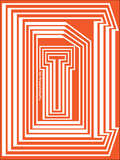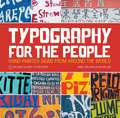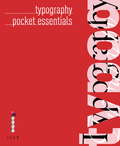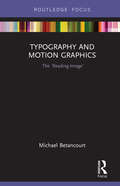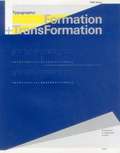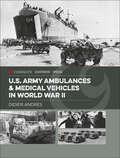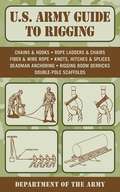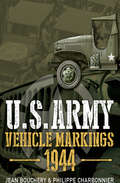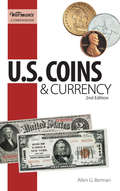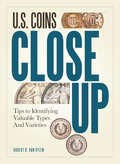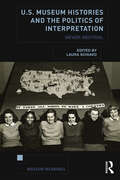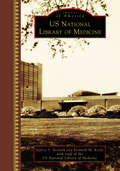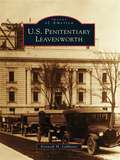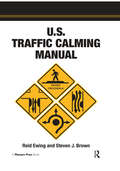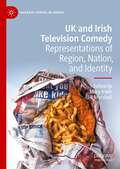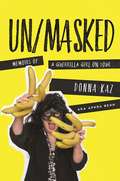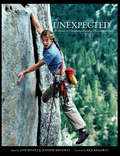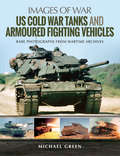- Table View
- List View
Typography 33
by Type Directors ClubFor over fifty years, the Type Directors Club has encouraged the worldwide graphic arts community to achieve excellence in typography through its annual international competitions. Typography 33 is the only annual devoted exclusively to typography and presents the finest work in the field for the year 2011. Selected from approximately 2300 international submissions to the annual Type Directors Club competition, the winning designs are models of excellence and innovation in the use of type design, representing a wide range of categories including books, magazines, corporate identities, logos, stationery, annual reports, video and web graphics, and posters.
Typography For The People
by Daniel Bellon Klaus BellonStreet + Art = Inspiration Designers Daniel and Klaus Bellon have been photographing street signage around the world for more than 17 years. This book celebrates their love of typography, and highlights the beauty of type in its truest form; not as a profession but as a necessity of everyday life. The images captured here are at times humorous, unexpected and even charming. But for those who understand the rules that are being broken, these explorations of type design are refreshing and inspiring. Even though graphic designers often think of themselves as the keepers of letterforms and typography, they do not own them. Typography belongs to everyone. Typography belongs to the people. Includes a royalty-free CD with 15 original fonts inspired by signs in the book. Type images were collected from countries around the world, including the United States, Dominican Republic, Puerto Rico, Belize, Canada, Colombia, Venezuela, Hong Kong, China, Singapore, and Malaysia.
Typography Pocket Essentials: Typography
by Alistair Dabbs Alastair CampbellTypography is the most ubiquitous of the graphic arts, with all of us now having access to innumerable fonts and the typographic tools that can, in the right hands, lift any text from the mundane to the beautiful.Opening with an overview of the history of the art, Typography Pocket Essentials introduces the key principles and techniques of typography, and presents 200 of the most useful and important fonts, making it a handy primer and essential reference guide all rolled into one.- Learn the rich history of the art, from Gutenberg to Neville Brody and beyond- Master the principles of effective typography and create beautiful documents yourself- 200 key fonts are profiled for easy reference and rapid selection
Typography and Motion Graphics: The 'reading-image' (Routledge Studies In Media Theory And Practice Ser.)
by Michael BetancourtIn his latest book, Michael Betancourt explores the nature and role of typography in motion graphics as a way to consider its distinction from static design, using the concept of the ‘reading-image’ to model the ways that motion typography dramatizes the process of reading and audience recognition of language on-screen. Using both classic and contemporary title sequences—including The Man With the Golden Arm (1955), Alien (1979), Flubber (1998), Six Feet Under (2001), The Number 23 (2007) and Scott Pilgrim vs. The World (2010)—Betancourt develops an argument about what distinguishes motion graphics from graphic design. Moving beyond title sequences, Betancourt also analyzes moving or kinetic typography in logo designs, commercials, film trailers, and information graphics, offering a striking theoretical model for understanding typography in media.
Typography for the People
by Daniel Bellon Klaus BellonStreet + Art = InspirationDesigners Daniel and Klaus Bellon have been photographing street signage around the world for more than 17 years. This book celebrates their love of typography, and highlights the beauty of type in its truest form; not as a profession but as a necessity of everyday life. The images captured here are at times humorous, unexpected and even charming. But for those who understand the rules that are being broken, these explorations of type design are refreshing and inspiring. Even though graphic designers often think of themselves as the keepers of letterforms and typography, they do not own them. Typography belongs to everyone. Typography belongs to the people. Includes a royalty-free CD with 15 original fonts inspired by signs in the book. Type images were collected from countries around the world, including the United States, Dominican Republic, Puerto Rico, Belize, Canada, Colombia, Venezuela, Hong Kong, China, Singapore, and Malaysia.
Typography for the People: Hand-Painted Signs from Around the World Plus 15 Free Fonts
by Daniel BellonStreet + Art = InspirationDesigners Daniel and Klaus Bellon have been photographing street signage around the world for more than 17 years. This book celebrates their love of typography, and highlights the beauty of type in its truest form; not as a profession but as a necessity of everyday life. The images captured here are at times humorous, unexpected and even charming. But for those who understand the rules that are being broken, these explorations of type design are refreshing and inspiring.Even though graphic designers often think of themselves as the keepers of letterforms and typography, they do not own them.Typography belongs to everyone.Typography belongs to the people. Includes a royalty-free CD with 15 original fonts inspired by signs in the book.Type images were collected from countries around the world, including the United States, Dominican Republic, Puerto Rico, Belize, Canada, Colombia, Venezuela, Hong Kong, China, Singapore, and Malaysia.
Typography: Introduction To Typographic Process
by Willi KunzTypographic design begins with a set of information and a concept. The designer, facing a blank sheet of paper or a computer screen, is anxious about the first step to take in developing a design. The elements of typography are an obvious starting point, but often do not get the attention they deserve.
Typography: Typography (Pocket Essentials Ser.)
by Graham Davis'Typography' opens with an overview of the history of the art, before going on to introduce the key principles and techniques of effective typography. A full introduction of the most useful and important fonts completes the book, allowing you to choose the right one every time. With this handy primer, anyone can master the basic principles of type layout and create pages that are easy on the eye and captivate the reader.
Türen im Duett: Autorinnen aus Ost und West im poetischen Dialog
by maki starfield/Yesim AgaogleEin literarischer Dialog zweier Schriftstellerinnen aus verschiedenen Kulturen und Kontinenten, die das gemeinsam und getrennt Erlebte in Worte bringen.
U-Boats off the Outer Banks: Shadows in the Moonlight (Military)
by Jim BunchFrom January to July 1942, more than seventy-five ships sank to North Carolina’s “Graveyard of the Atlantic” off the coast of the Outer Banks. German U-boats sank ships in some of the most harrowing sea fighting close to America’s shore. Germany’s Operation Drumbeat, led by Admiral Karl Donitz, brought fear to the local communities. A Standard oil tanker sank just sixty miles from Cape Hatteras. The U-85 was the first U-boat sunk by American surface forces, and local divers later discovered a rare Enigma machine aboard. Author Jim Bunch traces the destructive history of world war on the shores of the Outer Banks.
U.S. Army Ambulances & Medical Vehicles in World War II (Casemate Illustrated Special)
by Didier AndresA “cool compendium” of photos and information about the vehicles that helped save American troops’ lives (Cybermodeler).Of all the armies involved in World War II, the U.S. Army developed the most sophisticated system for the transport and treatment of injured and sick soldiers, pushing the boundaries of available technology to give their men the best chance of not only survival but a full recovery.Each infantry regiment had a medical detachment tasked with conserving the strength of the regiment by not only providing medical and dental treatment but also undertaking all possible measures to keep the regiment healthy. In combat they would provide emergency medical treatment on the battlefield, then move casualties to aid stations they had established. At aid stations, casualties would be triaged, stabilized, and treated before being moved on for further treatment. Vehicles formed a crucial part of the Medical Detachment’s equipment.This fully illustrated, comprehensive book covers all types of medical vehicles used both in-theater and in the United States, including ambulances and technical support vehicles. It details vehicle markings modifications, for use in the evacuation of troops from the battlefield, and the other uses these vehicles were adapted for during the war—including their use as “Clubmobiles” and “Chuck Wagons” by the American Red Cross.
U.S. Army Guide to Rigging (US Army Survival)
by ArmyHave you ever tried to rig your own sailboat? How about tying up the boat to the dock? Have you ever made a ladder or hoist? Learning rigging can be tricky, but with the U.S. Army Guide to Rigging (FM 5-125), you'll learn everything you need to know about rigging, from how to properly tie a rope to a rock to how to make rope chairs and build whole scaffolding structures! This comprehensive guide is full of crucial rigging techniques, procedures, and applications used in both dire and everyday situations everywhere by the U.S. Army.This informative and thorough guide draws upon the real-life experiences of soldiers installed in positions around the globe, whose duties require rigging, in all its variations and forms. Topics include the necessary usage of fiber rope, wire rope, and chains--used in multiple combinations and twists--to lift heavy loads. On the more basic side, it includes basic instructions on tying all manner of knots, hitches, splices, tackle systems, and more. Complete with illustrated diagrams to make it easy to follow along, anyone can access easy-to-learn rigging lessons that will come in handy both in your daily life and when you least expect it!
U.S. Army Vehicle Markings, 1944
by Jean Bouchery Philippe CharbonnierAn illustrated guide to the markings used on WWII Era U.S. Army tanks, lorries and Jeeps—an invaluable reference for historians, modelers and collectors. The markings of a 1944 U.S. Army Jeep are an iconic image of American military and the Second World War. But few people know what the distinctive white letters, numbers and symbols actually mean. This uniquely detailed guide explains how these and other markings were integral to organizing the U.S. Army on the move. U.S. Army Vehicle Markings 1944 covers all the markings used on American military vehicles to denote their unit and classification. It also covers tactical markings and the debarkation codes used in the Normandy landings. Hundreds of contemporary photographs are paired with precise color diagrams to show exactly how markings appeared on vehicles, including the exact measurements. The volume explains all the variations in the use of these markings and includes a chapter on the varieties of camouflage used on vehicles.
U.S. Bank Stadium: The New Home of the Minnesota Vikings
by Steve BergIn the summer of 2016, the State of Minnesota and the Minnesota Vikings football team will unveil a new, state-of-the-art stadium in Minneapolis. More than a monument to football, U.S. Bank Stadium stands as a community space that hosts a range of events and activities, reinvigorating a long-neglected area of downtown. U.S. Bank Stadium provides a comprehensive inside look at all that went into building the largest construction project in state history―what makes it a distinctive football facility, and what it means for Minnesota. Author Steve Berg describes the complicated and controversial history and path to approval; the various design concepts and innovations; the many phases of construction; the stadium’s place as a civic asset and its statewide legacy; and the full celebration of the facility’s grand opening. The book features profiles of and interviews with the central figures in U.S. Bank Stadium’s development, from architects and engineers to construction workers and groundskeepers, as well as players, fans, and community leaders. The book is heavily illustrated with design drawings and plans; construction photos chronicling everything from groundbreaking to opening day; detailed images of the stadium’s features and amenities; behind-the-scenes shots of the stadium operation; and game-day photos of fans, players, vendors, and more.
U.S. Coins & Currency, Warman's Companion (Warman's Companion)
by Allen G. BermanThis new edition of this coins and currency guide serves both experienced and entry-level collectors in your search for updated values and answers about U.S. coins and paper money. Written in a comfortable instructional tone, this book walks you through the evolution of U.S. money, spotting mint marks, and grading and handling coins; en-route to identifying and pricing all types of coins including State Quarters, new Nickels, gold coins, and paper money including treasury notes, silver certificates and demand notes, among others.
U.S. Coins Close Up: Tips to Identifying Valuable Types and Varieties
by Robert R. VanryzinTake a Closer LookIs that coin in your hand the real deal or a clever fake? Discover the difference with U.S. Coins Close Up, a one-of-a-kind visual guide to every U.S. coin type. This handy reference features large and clear images that detail inscriptions, mintmarks and initials, as well as thorough descriptions and fascinating coin history.Author and renowned numismatist Robert R. Van Ryzin takes a keen and careful look at U.S. coins, with in-depth denomination overviews, highlights of remarkable coins and an extended glossary of terms and features. No matter your level of expertise, this invaluable resource will leave you more knowledgeable and better prepared to spot that carefully altered coin - and save you from making an expensive mistake.
U.S. Museum Histories and the Politics of Interpretation: Never Neutral (Museum Meanings)
by Laura SchiavoU.S. Museum Histories and the Politics of Interpretation is the first collection to examine the history of museums in the United States through the lens of the political and ideological underpinnings at the heart of exhibitions, collecting, and programming. Including contributions from historians, art historians, anthropologists, academics, and museum professionals, the book argues that museums have always been embedded in the politics and culture of their time – whether that means a reification of hegemonic notions of race, gender, and progress or a challenge to those normative structures. Contributions probe the political nature of collection and interpretation as concept and practice, and museum work as both reflective of and contributing to the politics and circulation of power in different historical moments. As a whole, the volume provides detailed readings of museums that demonstrate the ways in which these trusted cultural institutions have intervened in shifting concepts of nation, community, indigeneity, race, citizenship, inclusion, identity, localism, and memory. U.S. Museum Histories and the Politics of Interpretation makes arguments about the historically and politically rooted nature of cultural production in museums that apply to institutions across the globe. It is essential reading for students and scholars of museum studies, public history, cultural history, art history, and memory.
U.S. Museum Histories and the Politics of Interpretation: Never Neutral (Museum Meanings)
by Laura SchiavoU.S. Museum Histories and the Politics of Interpretation is the first collection to examine the history of museums in the United States through the lens of the political and ideological underpinnings at the heart of exhibitions, collecting, and programming.Including contributions from historians, art historians, anthropologists, academics, and museum professionals, the book argues that museums have always been embedded in the politics and culture of their time – whether that means a reification of hegemonic notions of race, gender, and progress or a challenge to those normative structures. Contributions probe the political nature of collection and interpretation as concept and practice, and museum work as both reflective of and contributing to the politics and circulation of power in different historical moments. As a whole, the volume provides detailed readings of museums that demonstrate the ways in which these trusted cultural institutions have intervened in shifting concepts of nation, community, indigeneity, race, citizenship, inclusion, identity, localism, and memory.U.S. Museum Histories and the Politics of Interpretation makes arguments about the historically and politically rooted nature of cultural production in museums that apply to institutions across the globe. It is essential reading for students and scholars of museum studies, public history, cultural history, art history, and memory.
U.S. National Library of Medicine (Images of America)
by Jeffrey S. Reznick Kenneth M. Koyle Medicine, with staff of the US National Library ofThe US National Library of Medicine, on the campus of the National Institutes of Health in Bethesda, Maryland, has been a center of information innovation since its beginnings in the early 19th century. The world’s largest medical library and a federal government agency, it maintains and makes publicly available a diverse and world-renowned collection of materials dating from the 11th to the 21st centuries, and it produces a variety of electronic resources that millions of people around the globe search billions of times each year. The library also supports and conducts research, development, and training in biomedical informatics and health information technology, and it coordinates the National Network of Libraries of Medicine that promotes and provides access to health information in communities across the United States. As the library anticipates its third century of public service, this book offers a visual history of its development from its earliest days through the late 20th century, as the institution has involved generations of visionary leaders and dedicated individuals who experienced the American Civil War, the world wars, the Cold War, and the dawn of the information age.
U.S. Penitentiary Leavenworth (Images of America)
by Kenneth M. LamasterOn July 1, 1895, under the direction of warden James French, the first federal prison was born. That same year, St. Louis architects Eames and Young went to work drawing up plans for an institution that would house the most notorious offenders in the nation's history. At sunrise on March 1, 1897, 300 inmates and 30 guards marched three miles to the construction site located on the southwest corner of the military reservation. From sunup to sundown seven days a week in the hot Kansas summer to the harsh prairie winters, inmates labored building their new home. Leavenworth's rich history as a gateway to the Old West is second to none. Name a famous figure such as George Armstrong Custer, John Joseph Pershing, Dwight D. Eisenhower, or Colin Powell. They have all graced the streets of this historic community. Equally pick a name of the most notorious criminals. George "Machine Gun" Kelly, Robert F. Stroud, Frank Nash, Frank "the Enforcer" Nitti, and George "Buggs" Moran--they all stopped by to "spend time in Leavenworth."
U.S. Traffic Calming Manual
by Reid EwingA comprehensive how-to manual for traffic calming in the United States. Planners and engineers can look to this manual for guidance on the appropriate use, design, and signing and marking of traffic-calming measures. For local officials, developers, and community associations, it is an introduction to the goals and tactics of traffic calming. Based in part on the first traffic-calming manual taken through a formal rule-making process and adopted by a state department of transportation as a supplement to its roadway design manual, this book catalogs principles that have been modified by many local jurisdictions to match local priorities and preferences. Standardization is key to the success of traffic-calming initiatives, and this book explains the processes, tools, and design needed to create a standard traffic-calming program. It also shows how municipalities can build needed flexibility into such programs. Signage and markings are also key, and a chapter is devoted to these issues. This is the book that states and municipalities need to create effective traffic-calming programs.
UK and Irish Television Comedy: Representations of Region, Nation, and Identity (Palgrave Studies in Comedy)
by Jill Marshall Mary IrwinThis book looks at television comedy, drawn from across the UK and Ireland, and ranging chronologically from the 1980s to the 2020s. It explores depictions of distinctive geographical, historical and cultural communities presented from the insiders’ perspective, simultaneously interrogating the particularity of the lived experience of time, and place, embedded within the wide variety of depictions of contrasting lives, experiences and sensibilities, which the collected individual chapters offer. Comedies considered include Victoria Wood’s work on ‘the north’, Ireland’s Father Ted and Derry Girls, Michaela Coel’s east London set Chewing Gum, and Wales’ Gavin and Stacey. There are chapters on Scottish sketch and animation comedy, and on series set in the Midlands, the North East, the South West and London’s home counties. The book offers thoughtful reflection on funny and engaging representations of the diverse, fragmented complexity of UK and Irish identity explored through the intersections of class, ethnicity and gender.
UN/MASKED: Memoirs of a Guerrilla Girl on Tour
by Donna KazUN/MASKED, Memoirs of a Guerrilla Girl On Tour! follows the surprising 25 year journey of a young, New York City actress swept off her feet by a rising movie star who carries her to Malibu and back for a three-plus year love affair that is both fantastical and physically dangerous. When Nicole Brown Simpson and Ron Goldman are murdered in Brentwood she hears a bell go off, awakening her angry, activist spirit. Always an outsider, she takes one step further into invisibility and becomes a Guerrilla Girl, a feminist activist who never appears in public without wearing a rubber gorilla mask and who uses the name of a dead woman artist instead of her own. As a Guerrilla Girl, Aphra Behn creates comedic art and theater that blasts the blatant sexism of the theater world while proving feminists are funny at the same time.These two narratives-that of a young victim of domestic violence at the hands of a successful film actor and that of an artist so fed up with sexism in the theater world that she puts on a gorilla mask and takes the name of a dead woman artist to provoke change-have been lived by one woman. Donna Kaz offers her compelling firsthand account-illuminated by more than thirty behind-the-scenes photographs, stickers and posters -of her transition from a silent observer to an unapologetic activist.This is the memoir of a woman-turned-survivor-turned-radical-feminist who takes off her mask and, by merging her identities, reveals all.
UNEXPECTED
by Rick Ridgeway Jennifer Ridgeway Jane SievertFrom the peak of a mountain or the barrel of a wave, Patagonia has collected some of the most spectacular sports imagery in history. Relive the achievements captured in Patagonia's history, as well as the joie de vivre fostered by nurturing a relationship with the great outdoors.Unique for a business enterprise, Patagonia's catalog devotes fully half its space to nonselling editorial content - to environmental and sport essays and above all to extraordinary photographs of wild places and active pursuits for which the company makes its clothes. Since 1980, Patagonia has invited customers and wilderness photographers to submit their best, most unexpected shots of life outdoors - of alpine climbing, bouldering in the desert, skiing untracked bowls, surfing secret spots, ocean crossings, first kayak descents and travel in unfamiliar places. The photos have poured in ever since (current rate: 60,000 per year), some from the famous (John Russell, Galen Rowell), others from respected photographers (Corey Rich) who had their first work published in these pages. Jane Sievert and Jennifer Ridgeway, Patagonia's current and founding photo editor, respectively, have been calling - and culling - the shots for three decades. This is their compendium of the 100-plus most compelling photos Patagonia has published - and a celebration of wilderness and outdoor-sport photography as an art and a practice.
US Cold War Tanks and Armoured Fighting Vehicles: Rare Photographs from Wartime Archives (Images of War)
by Michael GreenThis expert study of the U.S. military&’s armored vehicles deployed during the Cold War features rare photographs from the wartime archives. To counter the Soviet threat and that of their client States during the Cold War years 1949-1991, the American military deployed an impressive range of main battle tanks and armored fighting vehicles. Expert author Michael Green presents a detailed study of these vehicles and their variants in this informative volume of stunning wartime photographs. The Patton series of medium main battle tanks—including the M46, M47 and M48—supplemented by the M103s Heavy Tank initially formed the core of the US tank fleet. In 1960 the M60 MBT entered service and, in turn, was replaced by the M1 Abrams in 1980. In support were armored reconnaissance vehicles, progressively the M41 bull dog (1951); the M114 (1961), the M551 Sheridan (1967) and M3 Bradley Cavalry Fighting Vehicle (1981). The armored personnel carrier range included the ubiquitous M113 and its replacement the M2 Bradley, cousin of the M3. All of these vehicles are covered in this highly detailed volume in the Images of War series.
